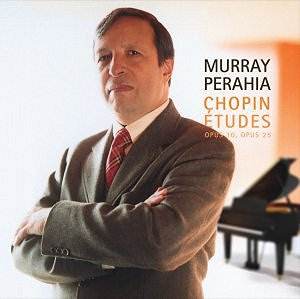Two of the greatest 20th Century exponents
of Chopin, Horowitz and Rubinstein, apparently hesitated over recording
these studies complete; the first pianist to do so, unlikely as it may
seem, was Wilhelm Backhaus. The earliest complete recording which has
remained with us ever since was that of Alfred Cortot. Though sometimes
derided as both an approximate technician and an empirical interpreter,
Cortot did understand that what will transform these pieces from mere
exercises to pure poetry is a delight in the ravishing sound they make.
No one would have doubted that Perahia has all the
necessary technique to play these pieces; nor has he ever been a pianist
who has made digital dexterity his visiting card. As an interpreter
of Bach, Mozart, Beethoven, Schubert and often of Chopin he has always
put musical values first. Unfortunately on this occasion he has not
always transcended the purely mechanical aspects of the music. The first
two studies emerge somewhat dryly and the dynamics are not always those
written in the score. In the last five bars of no. 2, for example, Chopin
has written (unless it can be shown that the Polish edition is wrong)
a crescendo to forte then a diminuendo. Perahia substitutes this with
a long diminuendo to end piano.
In no. 3 one appreciates that he does not drool over
the music, but he seems bumpy and uncaring. No 5 lacks the written forte/piano
contrasts and in general those studies which depend on light-fingered
sparkle for their particular magic – 5, 7 and 8, of which the latter
is decidedly brusque – are disappointing. A hint of the missing magic
appears on the last page of no. 10 but no. 11 is rather noisy and driven
and the so-called "revolutionary" is well-managed rather than
thrilling. The final pedal change of no. 6 is badly managed and might
have been re-made.
For whatever reason, op. 25 is more successful. In
the first Perahia’s careful placing of the inner voices is to be appreciated
and the second finds at last that pleasure in the light sonorities which
eluded him earlier. Unfortunately it eludes him again in no. 3 which
emerges as a hard-driven galop but he makes the dialogue between
the voices speak effectively in no. 7. From here to the end I have only
praise; 8 and 9 have the light touch so often lacking elsewhere and
the last three are suitably powerful, but with some nice lyrical playing
in the middle section of the "octave" study as well.
I am sorry not to have found more to admire here since
Perahia’s high reputation is thoroughly deserved. He has made many discs
which will, I believe, preserve his name for future generations; one
such may be that of the Bach Goldberg Variations which I recently discussed
in a comparative review. The present CD will not, I venture to suggest,
be remembered among his greatest successes.
Christopher Howell


